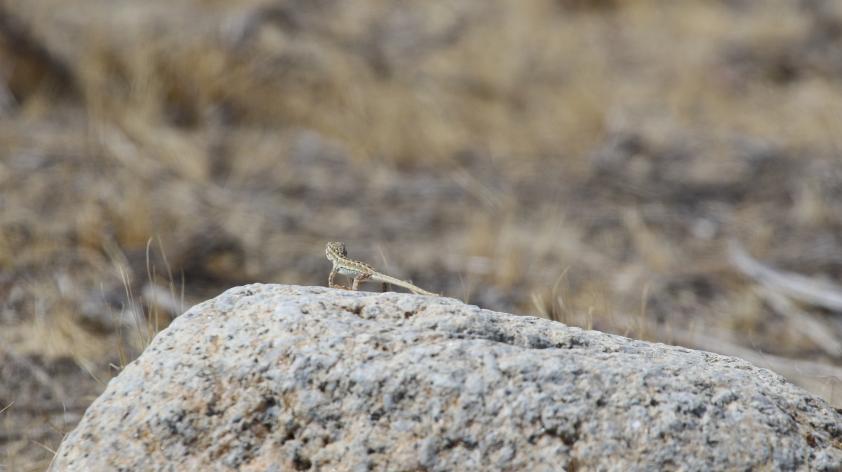
Where have all the biologists gone?
“There are 186 applications.” That was the sentence that I kept saying in my head when we started reviewing the pool of candidates for the Rookies for Recovery Program.
Apparently, up and coming biologists aren’t being trained the way they should be, or at least the way that current agencies want or need them to be. But what we didn’t consider is that those up-and-comers, or Rookies, want the training just as badly as agencies think they need it. In just six days the program attracted nearly 200 applications for its 5 temporary positions.
Responding to over 90% of agencies reporting deficiencies in the training and skill development of early career botanists and biologists, the Bureau of Land Management, the Center for Plant Conservation and the San Diego Zoo Institute for Conservation Research developed a partnership to collaborate on the development of a new kind of experiential learning opportunity for budding scientists.
Rookies for Recovery, a pilot internship program, selected 5 post-baccalaureate participants to undergo an intensive training led by field researchers and government agency representatives that would prepare them for a 5-month, full-time internship placement within a BLM office or field station. The week-long orientation and training was held at the Arnold and Mabel Beckman Center for Conservation Research in May 2018, after which interns were placed at their respective BLM sites. During their in-office placement, interns worked closely with a BLM biologist as a mentor on various projects assisting in the recovery, management, and monitoring of federally threatened or endangered species.
Makenna Spencer interned with the Royal Gorge office in Colorado and committed her internship time to several projects including conducting Snowshoe Hare surveys to estimate viable lynx habitat range, bat acoustic monitoring, Mexican spotted owl surveys, Degener’s Beardtongue (Penstemon degeneri) demographic monitoring, Brandegee’s Buckwheat (Eriogonum brandegeei)population monitoring, and Penland Alpine Fen Mustard (Eutrema penlandii) population monitoring. You can check out her blog here.
Jessica Sattler interned with the Grants Pass office in Oregon and focused her internship mainly on Fritillary species management. She also contributed to the seed collection and storage of other plant species (Achnatherum lemmonii, Clarkia rhomboidea, and Lomatium cookii), assisted in the mapping and treatment of weed populations near the Areas of Critical Environmental Concern, helped investigate the fire damage inflicted on two of the Fritillary Management Areas, and helped document vegetation in great grey owl habitat. Visit Jessica’s blog here.
Leiloni Wonch, stationed at the Coachella Valley field office in Palm Springs, California, used her internship time to assist on projects regarding desert tortoise habitat assessment, water quality monitoring in the Santa Rosa Mountains, vegetation monitoring for restoration in the Big Morongo Canyon, and assisting with drafting proposals for potential citizen science projects centered around the desert tortoise and the Southwestern pond turtle. Learn more about Leiloni’s experience here.
Emmeleia Nix interned with the Central Coast field office in Marina, California and spent a considerable amount of her internship in the field assisting on projects with reptile and amphibian species. She mainly focused on the blunt-nosed leopard lizard, using radio telemetry to track their movements and conducting shrub/burrow and food availability surveys. Read about Emmeleia’s internship here.
Kim Watts was assigned to the El Centro Field office in California and focused her internship time working on a variety of projects centered around desert species like the peninsular bighorn sheep, flat-tailed horned lizard, desert pupfish, and desert tortoise. She assisted in inspecting natural and artificial water sources for bighorn sheep, completed surveying protocols for the flat-tailed horned lizard, helped monitor the restoration of temporarily impacted areas critical to the Quino checkerspot butterfly and the peninsular bighorn sheep, monitored water levels in desert pupfish habitat areas, and assisted in monitoring desert tortoise burrowing sites. You can check out Kim’s blog here.
The steady churn of thoroughly trained field biologists with real hands-on experience is pivotal to the making of sound decisions for land management, conservation, and environmental policy as well as for the betterment of science. If there are fewer and fewer well-trained biologists in the upcoming generations, who will be left to do the decision-making? We must look beyond our reliance on traditional academia to provide this training, and potentially fill the gaps in innovative and collaborative ways.
For me, the opportunity to coordinate the pilot year of a program like Rookies for Recovery has been an amazing experience. I feel so fortunate to have been part of the development and mentorship of such inspirational scientists. Passion for science is contagious and we should seek ways to use that passion with our respective organizational expertise to our advantage. Some might wonder, where have all the biologists gone? I have found that if you call, they will eagerly come.













